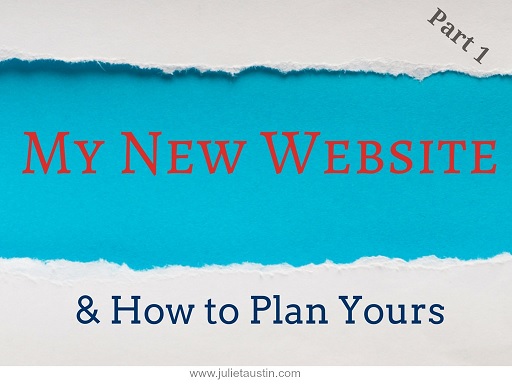If you are a regular visitor to my website, you may have noticed that my site has been re-designed. You can check out the home page here. I’m thrilled with how it turned out and have been receiving lots of positive comments on it. I hope you like it too.
Because getting a natural health or therapist website design is a lot of work—even when you are hiring people to do most of the work for you—I thought I’d share my process with you and provide some guidelines on getting your own website redesigned.
If you haven’t had your website re-designed for several years, you might want to consider doing it this year. Getting a re-design every 2-4 years is ideal to keep your site looking fresh and current with up-to-date content. Furthermore, web design trends constantly change as do how people use websites. A website that is out of date and looks stale can hurt, rather than help you.
This is the 1st part of a 2-part article. It is jam-packed with helpful information that will serve as a useful guide when planning a re-design for your practice or holistic business website.
In part 1 of this article, below I discuss the planning stage of creating a new website, how to make sure your target audience or niche is clear and focused, and the types of content that work best to convert web visitors into clients or customers.
In part 2 of this article, I cover design elements that you’ll need to consider when re-designing your website, as well as on-page search engine optimization practices. This helps Google know where to index your site and helps your site rank as high as possible.
Planning a Natural Health or Therapist Website Design
Goals of the Website
You might think that the only goal of a therapy practice or wellness business website is to attract more customers and clients, but this is not always the case.
Before you begin any website, you should be clear on what the main goal of your website is as well as any secondary goals.
The main goal of my new site is to get more email subscribers because my primary marketing tool is my email list. If you’ve been a subscriber to my list for a while, you’ll know that I use my list to keep in touch with my subscribers by sharing helpful marketing articles with them. I also use my email list to market the courses that I offer.
My secondary goal for my website is to attract clients for my individual consulting and copywriting services.
As you’ll see below, my site is designed with the above goals in mind.
Gathering Information
Because I spend a lot of time on the web viewing websites and reading about those that work, I knew what I liked and what type of website would perform best before I approached my web designer.
Whenever I visit a website and see something I like, I make a note of it either for my own purposes or as examples to show my clients. For my website re-design, I also created a private board on the social media platform, Pinterest to keep track of websites that I liked.
In addition, I created an outline of the web pages for my site and kept notes for all the written content in Evernote.com. You can keep notes in a paper folder or notebook if you prefer. Use whatever system works best for you, as long as it is organized and easy to access later when the design and writing process begin.
You will be more satisfied with your website if you view a lot of different websites before you begin to work with a web designer. Make a note of the specific aspects of what you like and don’t like for each site, so that you can later send these details and website URLs to your designer.
By the way, it’s important that you look beyond natural health and therapist websites for ideas because they are not necessarily the best examples of websites that work well.
Clarity of Target Audience or Niche
Target or Niche Audience
Before you do too much planning for your natural health or therapist website, you’ll want to make sure you are crystal clear on your target audience or niche, as well as your overall message. Your target audience will determine what content you put on your site, and will also play a role in the design you choose for your website.
My niche has been the same for the 16 years I’ve had my business. It’s therapists and healing professionals who want help in building their businesses or practices, or who want to attract more clients via compelling website copy.
Even though my niche is well established, I wanted to tweak the focus a bit and attract more natural health or wellness businesses that were not necessarily practitioners or clinicians. This is because I am passionate and knowledgeable about both physical and mental health and love working with businesses that focus on these areas.
Do you need to have a niche?
The short answer is no, but it can help if there are people who want what you have to offer, and if you market to them effectively.
If you decide not to have a niche, you should at least have some clarity around your target audience — the demographics and/or characteristics of the clients or customers you want to attract. Otherwise, it’s going to be more challenging to have a focused message and to write compelling copy because you won’t be able to be specific.
Further, if you want to stand out from others, having a niche is a good way to do that. Remember, depending on the geographic location/s you are marketing to, there could be hundreds, thousands, or more professionals or businesses competing with you. The more specific you are, the more unique and competitive you will be.
Deciding on whether to have a niche or which niche to have, is a struggle for a lot of people. Rather than spinning around in circles and not knowing what to do, get some help in making a decision on the best option for you.
Website Content
Website Pages
I kept some of the core pages from my old site, deleted a few others, and added a few new ones. I have 6 core pages on my website – Home, About, Work With Me, Praise Blog, and Contact and then secondary pages that can be accessed from these pages.
The praise (testimonials) page is a new page that didn’t exist on my old site (even though some of the testimonials are the same). On my old website I included testimonials on a sidebar on the right side of the page. But, I wanted a cleaner looking site this time, and thus put most of the testimonials on their own page.
For the 3 services that I offer, I created one main services page, plus 3 sub-pages accessed from the main page. Because I have several services, I wanted to have focused pages for each one. This makes it easier for web visitors to go the specific service they want to learn more about, while not having to read through information that doesn’t interest them. All of this makes my website more user-friendly.
When deciding on the pages to include in your natural health or therapist website design, you’ll want to include enough pages so that your website visitors have the information they want and get their questions answered. Unless you have a blog and offer courses or products, a typical number of pages might be from 5-7 (including the contact page).
When naming your pages, it’s a good idea to use standard names that are used on most websites. Your visitor’s brains are wired to look for page names based on what they are accustomed to seeing. For example, I suggest you always have a page called “Contact,” because this is a standard name for a page that allows visitors to get in touch with you.
Website Copy
While my overall message is primarily the same as it was on my old site, I re-wrote all the copy from scratch. Much of the home page copy on my old site had been there for several years, so it was time for a refresh.
Old content becomes stale after a while and can bore repeat visitors that visit your site. Businesses also evolve over the years, as do the needs of one’s target audience or niche, so it’s important to make sure your content is fresh and current.
Because I am a copywriter, I know how important it is to have a clear, compelling and targeted message. Since two brains are better than one, and it’s more challenging to write for myself than others, I hired a copywriter to help me tweak my home page copy after I wrote the first draft. I knew the money I invested would be well worth it, and it definitely was.
The revisions I made to the home page as a result of the feedback the copywriter gave me were invaluable. My copy is clearer, tighter and more compelling as a result.
Before you, or your copywriter begin to write your copy for your new therapist or natural health website, you should be clear on the overall message you want to convey that will resonate with your audience.
Your website copy should then follow proven copywriting principles. Effective web copy should stem from your marketing message and build a case for why people should work with, or buy from you. It should explain who your audience is, the struggles they face, what you have to offer, and the benefits of your services or products.
I’m a fan of longer style copy, because in many cases research shows it outperforms shorter copy. I’ve seen long-style copy work well repeatedly on my client’s websites, and it has served me well on my previous websites.
Longer web copy, as long as it is engaging and laid out in a way that makes it easily scannable (e.g. includes headlines, sub-headlines, bullet points, plenty of white space, etc.), can often convert more of your web visitors into clients and customers.
Why is this the case?
Because long-style copy allows you to provide more details, answers more of your web visitor’s questions, and can be more specific and convincing than shorter copy. It can draw readers in and make them feel like they are having a conversation with you. It can help them feel understood and hopeful. It can make them feel like they know you, your therapist services or natrual health products.
Does this mean every website visitor will read all of your copy if it’s long?
Of course not. However, many of your best clients and customers will likely read a lot of it because it will speak to them more deeply. They may not read it all at once, but over time, they may go back to your website many times before contacting you.
If you don’t hire someone to write your copy for you, I strongly suggest you study some basic copywriting principles before attempting to write your own copy. Writing engaging copy has nothing to do with having strong literary, academic, or professional writing skills. If you don’t have a basic understanding of this style of writing and the proven principles it is based upon, you won’t be able to do it effectively, and it will impact on your results.
Images/Photos
The use of photos and other images on your website is important because research has shown the brain process images 60,000 times faster than text. Images are also shown to affect your website visitors on an emotional level. Further, research shows that people make “buying” decisions based on their emotions. Since those visiting a therapist or natural health website are often experiencing difficult or painful emotions, the right images help resonate with your audience.
This doesn’t mean you should plaster images all over your site without a strategy. Don’t use images simply because you like them or because you think they make your site look pretty. Also, be careful that you don’t use too many images and distract from your message.
Images should be high quality, relevant to your message, and be purposefully placed. They should support and reinforce your copy, strengthening your overall message. Using images, like every other decision you make when planning your website, should be in alignment with your goals and what will work best for your audience.
There are plenty of stock photo websites out there where you can find free images and photos, but these sometimes can look ‘cheesy.’ You’ll often have to pay for high-quality images. Usually, the best option is to let your designer find them or create them for you. Or, if you are skilled at photography, you may want to take some of your own photos.
Photos of you, or your team, that are used on your website should be taken by a professional photographer. Getting good professional photos is not always easy. I’m not a 100% happy with the photos on my site, but they were the best ones of those that were taken. Sometimes you have to settle with what is “good enough” or you will never get things completed. In my case, I can easily get more professional photos taken later.
Other than my photo, I found and purchased all other images for my site and sent them to my designer. Again, this would normally be something a designer would do, but it was easier for me to get the images I wanted, rather than describe them to my designer and leave it up to her to find appropriate ones.
Welcome Video
Video has become huge on the web. While there are various types of videos used on websites, having a welcome video is a smart idea. As a visual medium, a welcome video gives your visitors a much better idea of who you are than a photo alone. It also allows you to deliver your message via another medium, in addition to the written word.
A good welcome video can increase your results substantially. While I am not aware of any statistics on video used on service-based sites, there is research that shows video on product-based websites can increase sales by 144%. On the other hand, having a poor quality or boring video can turn people away, rather than drawing them towards you. Therefore, you’ll need to ensure your video is done well.
A welcome video should typically be about 45 seconds to 1 minute in length. It should be just long enough to briefly tell people who you help, how you can help them solve their problems, the benefits you provide, a bit about you, your business and your credibility, and finally, a call to action telling your visitors what you would like them to do next. In essence, it’s a summary of your written message.
I focused on all of the above in my video. My call to action asks people to subscribe to my email list because acquiring email subscribers is the primary goal of my website.
Creating a compelling video can also be challenging. I recommend writing a script, practicing it until you memorize it, and then hiring a professional videographer to shoot it for you. There are many videographers that focus on doing welcome videos for businesses. I found one in Vancouver where I live who shot the video and edited it. My web designer’s partner then created a snazzy intro for it with music.
My video is not perfect. We are always most critical of ourselves though, and as I said above, sometimes we have to accept things as being “good enough.” While quality is important, extreme perfectionism only holds you back from completing your goals.
Email Subscribe Box
Email marketing is still considered one of the most effective methods of online marketing. I know this from the marketing research and also from my own personal experience.
Since my email list is the most important marketing tool I use for my business, my site is designed strategically to get my web visitors to subscribe to my list. I have, therefore, included two sign-up boxes on my home page – one near the top of the page next to the video and one at the very bottom of the page.
So far, my conversion rate (the # of visitors to my site vs. those that have signed-up for my email list) on the home page is higher than it was on my old site. However, there hasn’t been enough website visitors yet to see if these stats are statistically significant.
I’ve also included subscribe boxes on other pages of my site – on a sidebar on my blog pages, and also at the bottom of all blog posts. Finally, I’ve included text links on several places of my site asking people to sign up for my list. Having several options where people can sign-up for your list definitely increases subscribers.
I offer 3 free resources to those who sign up for my list. I do this for 2 reasons: 1) I like giving away free content because my subscribers tell me they appreciate it. 2) By giving away 3 free resources, I am increasing the value of signing up for my email list.
I recommend all my clients start collecting emails as soon as their website is up then and start creating quality content (blog posts, video, etc.) to send to their subscribers on a regular basis. Content marketing is key to successful online marketing.
Use of Social Proof
As I’ve discussed before, social proof is an important aspect of marketing because it eases the mind of potential clients and customers. Research shows that if people are not sure what to do, they will follow the example of others. This is why word of mouth marketing works so well, and is also why you see so many testimonials in marketing and advertising.
Testimonials may not always be appropriate for your particular audience. If this is the case, you might consider other forms social proof.
I included 2 types of social proof on my website. The first is client testimonials. I have short testimonials on my home page and on the bottom of other pages. I also have a full page of longer ones on my praise page. Including them on several pages like this keeps them in front of my audience and reinforces the message in my copy.
The second type of social proof I use on my website is on the subscribe button of my sign-up box which says, “Click here to join 10,000 of your peers.” Showing I have 10,000 subscribers indicates that a lot of people have signed up for my list which increases my credibility and creates the impression that signing up for my list must be worthwhile. Including this detail on my sign-up form should, therefore, help increase my subscriber rate.
The wording, “of your peers” is another way of showing social proof. It is intended to help people feel they are part of a group if they sign-up. This again illustrates how much the words you use in your copy matter.
Blog
As I’ve said above, content marketing/blogging is the most effective method of marketing online. I’ve been writing articles on my blog for several years now, and it has been key to my success. A blog shows your expertise, helps build trust, keeps visitors coming back to your site, and can help improve your search engine rankings.
People often avoid having a blog due to concerns about their writing abilities, the time it takes to write, and that they won’t have anything to write about. My response to these concerns is that you’ll become a better writer if you write more. And yes, blogging takes time, but all types of marketing take time. Finally, as long as you are listening to your clients and customers, you shouldn’t have any problems coming up with topics to write about.
Social Media Icons
If you have social media accounts that you use, you’ll want to include the follow icons for these somewhere on your site so that people can follow you in other places on the web. The typical place for social icons is on the top and/or bottom of your pages, or above or below your email subscribe box on a sidebar.
I chose to put mine at the top and bottom of my pages with one exception – I do not have them at the bottom of my home page because once people get to the bottom of that page, I would prefer they sign-up for my email list (if they haven’t already), as opposed to following me on my social media platforms.
If you give people fewer choices on a website, they are more likely to choose the option that you want them to. Moreover, if you have too many options, it can prevent them from taking any action at all.
If you have social media accounts but are not active on them, you might consider whether it’s worth it to put the social icons on your site. You don’t want people to click on the link only to go to your social media account and find that you haven’t posted new content in weeks or months. This doesn’t leave a good impression and wastes your web visitor’s time. When you waste people’s time or frustrate them, they are unlikely to stick around.
Summary of Part 1
As you can see, if you want a high-performing website, there are many steps that you’ll need to take before you get to the actual web design stage. As your website is the hub of your business or practice, it will serve you well to complete the above steps before heading to the web design process, which you can read about in part 2 of this article.
If you want help in planning your new website, you can book a phone consultation with me.
I’d love to hear your comments on questions on this post. Please add your comments to the comment section below.






[…] Your Natural Health or Therapist Website – example of an epic blog post from Juliet Austin […]